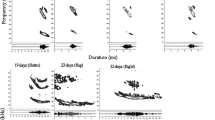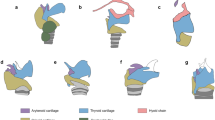Abstract
The ontogeny of echolocation in bats has received relatively little attention. Some bats do not hear at birth and are incapable of emitting the high frequency sounds necessary for accurate echolocation. No bat can fly at birth. Even bats born in a relatively advanced state, with the ability to hear and emit ultrasounds, still must learn to fly and correlate their outgoing pulses and returning echoes in a three-dimensional world before they are weaned. A study of echolocation ontogeny must integrate physiology, morphology, and behavior. The emission of short, high frequency sounds depends on the development of laryngeal musculature, but these ultrasonic pulses are of little value if the auditory system cannot process them or if the animal cannot maintain the high body temperatures necessary for ultrasonic hearing. All these systems develop simultaneously, and we have yet to assess the role of learning versus maturation in echolocation ontogeny. Our understanding of echolocation in adult bats can be enhanced through knowledge of how this complex sensory system develops.
Access this chapter
Tax calculation will be finalised at checkout
Purchases are for personal use only
Preview
Unable to display preview. Download preview PDF.
Similar content being viewed by others
References
Brown, P.E., Vocal communication and the development of hearing in the pallid bat, Antrozous pallidus, Ph.D. Thesis, UCLA, 144pp., 1973.
Brown, P.E., Vocal communication in the pallid bat, Antrozous pallidus. Zeit Tier Psychol., 41, 34–54, 1976.
Brown, P.E., Grinnell, A.D. and Harrison, J.E., The development of hearing in the pallid bat, Antrozous pallidus, J. Comp. Physiol., 126, 169–182, 1978.
Caley, D.W., Differentiation of the neural elements of the cerebral cortex in the rat. In: Cellular aspects of neural growth and differentiation. Ed., D. Pease, University of California Press, Los Angeles, pp. 73–102, 1971.
Davis, W.H., Barbour, R.W. and Hassell, M.D., Colony behavior of Eptesicus fuscus, J. Mammal, 50, 729–736, 1968.
Douglas, A.M., The natural history of the ghost bat, Macroderma gigas in Western Australia. W. Austral. Nat., 10, 125–137, 1967.
Gould, E., Echolocation and communication in bats, In: About Bats, Eds. B. Slaughter and D. Walton, Southern Methodist Univ. Press, Dallas, pp. 144–161, 1970.
Gould, E., Studies of maternalinfant communication and development of vocalizations in the bats Myotis and Eptesicus, Communications in Behavioral Biology, part A, 5, No. 5, pp. 263–313, March, 1971.
Gould, E., Neonatal vocalizations in bats of eight genera. J. of Mammalogy, 56, no. 1, 15–29, February, 1975a.
Gould, E., Experimental studies of the ontogeny of ultrasonic vocalizations in bats, Dev. Psychobiol., 8, 333–346, 1975b.
Gould, E., “Echolocation and Communication” in Biology of Bats of the New World Family Phyllostomatidae, Part II, Ed. Baker, R.J., J.K. Jones, Jr., and D.C. Carter, Special Publications the Museum Texas Tech. University, No. 13, pp. 247–279, 1977.
Gould, E., Infant calls of 10 species of Malaysian bats (Micro and Megachiroptera). Poster presented at Animal Sonar Systems Jersey Symposium, 1979.
Gould, E., Woolf, N.K. and Turner, D.C., Double-note communication calls in bats: occurrence in three families, J. of Mammal., Vol. 54, No. 4, 998–1001, 1973.
Grinnell, A.D. and Hagiwara, S., Adaptations of the auditory nervous system for echolocation. Studies of New Guinea bats, Z. vergl. physiologie, 76, 41–81, 1972a.
Grinnell, A.D. and Hagiwara, S., Studies of auditory neurophysiology in nonecholocating bats, and adaptations for echolocation in one genus, Rousettus. Zeit. Vergl. Physiol., 76, 82–96, 1972b.
Grinnell, A.D., The neurophysiology of audition in bats: Temporal parameters. J. Physiol.(Lond)., 167, 67–96, 1963.
Jones, C., Growth, development, and wing loading in the evening bat Nycticeius humeralis (Rafinesque), J. Mammal, 48, 1–19, 1967.
Kay, L. and Pickvance, T.J., Ultrasonic emissions of the lesser horseshoe bat, Rhinolophus hippersideros (Bech), Proceed. Zool. Soc., Lond., 141, 163–171, 1963.
Kikuchi, K. and Hilding, D.A., The development of the organ of Corti in the mouse. Acta Oto-Laryngal, 60, 207–222, 1965.
Konstantinov, A.I., Development of echolocation in bats in postnatal ontogenesis. Period Biol., 75, 13–19, 1973.
Konstantinov, A.I. and Stosman, I.M., Electrical activity in the inferior colliculus under the effect of ultrasound stimuli in ontogeny in bats of the genus Myotis oxygnathus. Zh. Evol. Biokhim. Fiziol., 8, 182–188, 1972.
Kulzer, E., Über die Jugendentwicklung der Angola-Bulldog fleder maus Tadarida (Mops) condylura, (A. Smith, 1933) (Molossidae). Säugeteirkundl. Mett., 10, 116–124, 1962.
Kunz, T.H., Population studies of the cave bat (Myotis velifer): reproduction, growth, and development. Occ. papers, Mus. Nat. Hist., Univ. of Kansas, 15, 1–43, 1973.
Matsumura, S., Mother-infant communication in a horseshoe bat (Rhinolophus ferrumequinum nippon), I. Development of vocalization. Submitted to J. Mamm., 1979.
Mikaelian, D. and Ruben, R.J., Development of hearing in the normal CBA-J mouse. Acta Oto-Laryngal,.59, 451–461, 1965.
Orr, R.T., Natural history of the pallid bat, Antrozous pallidus. Proc. Calif. Acad. Sci., 28, 165–248, 1954.
Orr, Robert T., “Development: Prenatal and Postnatal” in Biology of Bats. Vol. 1, Chapter 6, Ed. by W.A. Wimsatt, Academic Press, New York, pp. 217–231, 1970.
Pearson, O.P., Koford, M.R. and Pearson, A.K., Reproduction of the lump-nosed bat (Corynorhinus rafinesquii) in California. J. Mammal., 33, 273–320, 1952.
Porter, F.L., Social behavior and acoustic communication in the bat, Carollia perspicillata. Ph.D. dissertation, Washington University, 169pp., 1977.
Schmidt, V., Social calls of juvenile vampire bats (Desmodus rotundus) and their mothers. Bonn. Zool.. Beitr., 4, 310–316, 1972.
Schmidt, V. and Manske, V., Die jugendentwicklung der vampirfledermäuse (Desmodus rotundus). Z. Saugetierkunde, 38, 14–33, 1973.
Schnitzler, H.U., Die ultraschull-ortungslaute der Hufeisen-Fledermäuse (Chiroptera-Rhinolophidae) in verschiedenen Direntierungssituationen. Z. Vergl. Physiol., 89, 275–286, 1968.
Sher, A.E., The embryonic and postnatal development of the inner ear of the mouse. Acta Oto-Laryngal (Suppl), 285, 1–77, 1971.
Stosman, I.M. and Konstantinov, A., Characteristics of evoked potentials of inferior colliculus of the bat Rhinolophus ferrumequinum. Zh. Evol. Biokhim i Fiziol., 8, 612–616, 1972.
Weibel, E.R., Zur kenntnis der differenzieurungs-vörgange im epithel des ductus cochlearis. Acta Anatomica, 29, 53–90, 1957.
Woolf, N., The ontogeny of bat sonar sounds: with special emphasis on sensory deprivation. Unpublished doctoral thesis, Johns Hopkins University, Baltimore, Maryland, 140pp., 1974.
Author information
Authors and Affiliations
Editor information
Editors and Affiliations
Rights and permissions
Copyright information
© 1980 Plenum Press, New York
About this chapter
Cite this chapter
Brown, P.E., Grinnell, A.D. (1980). Echolocation Ontogeny in Bats. In: Busnel, RG., Fish, J.F. (eds) Animal Sonar Systems. NATO Advanced Study Institutes Series, vol 28. Springer, Boston, MA. https://doi.org/10.1007/978-1-4684-7254-7_15
Download citation
DOI: https://doi.org/10.1007/978-1-4684-7254-7_15
Publisher Name: Springer, Boston, MA
Print ISBN: 978-1-4684-7256-1
Online ISBN: 978-1-4684-7254-7
eBook Packages: Springer Book Archive




